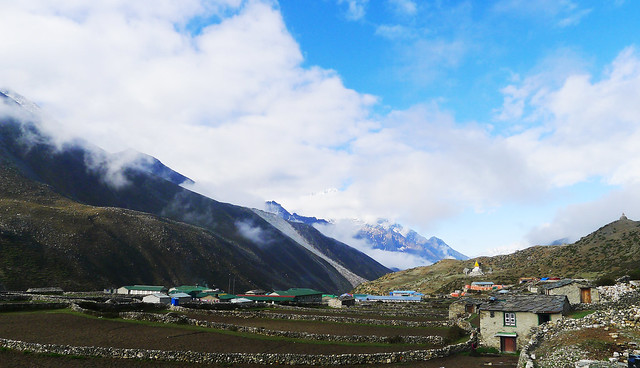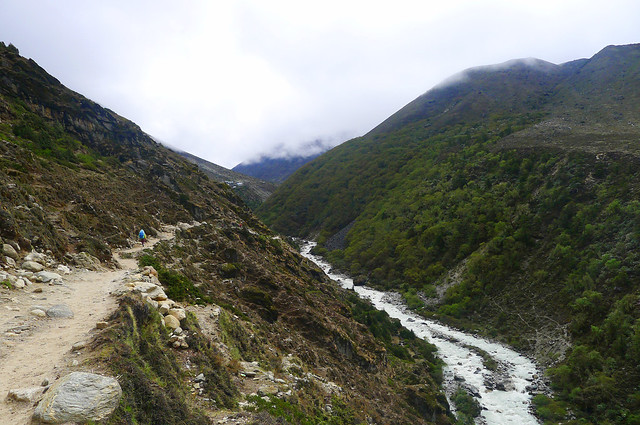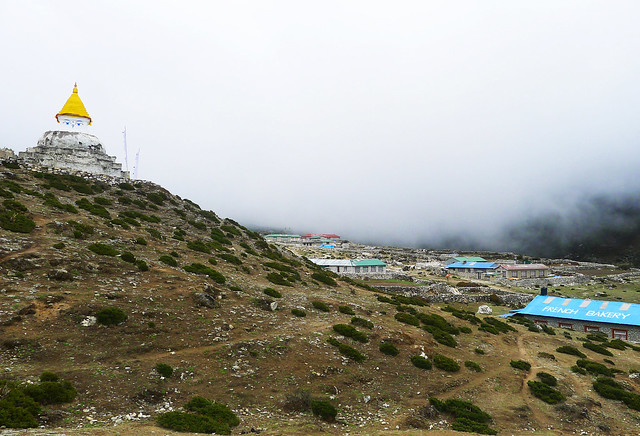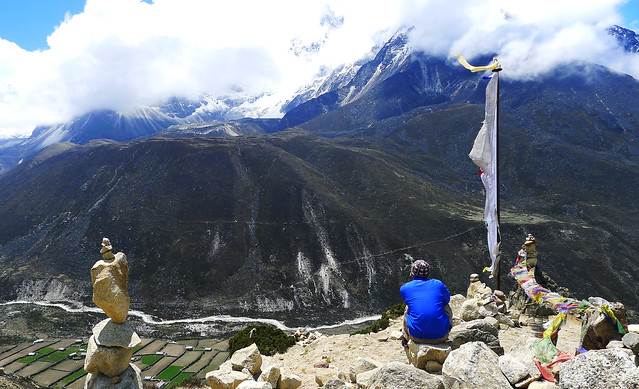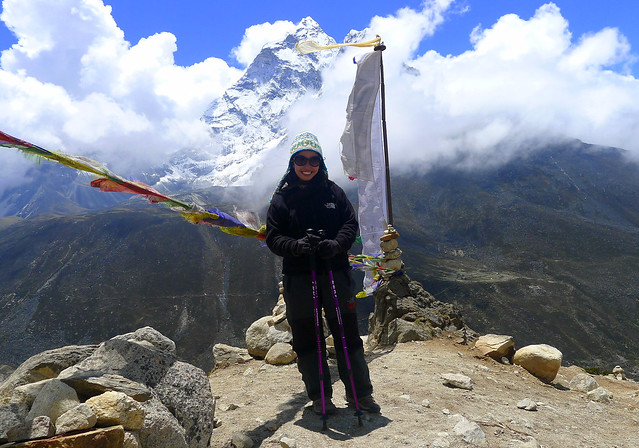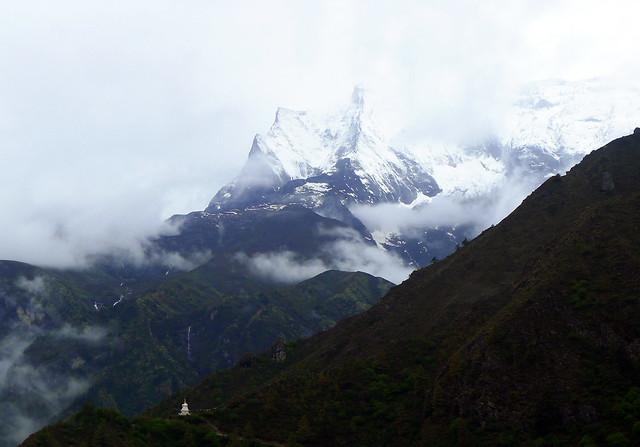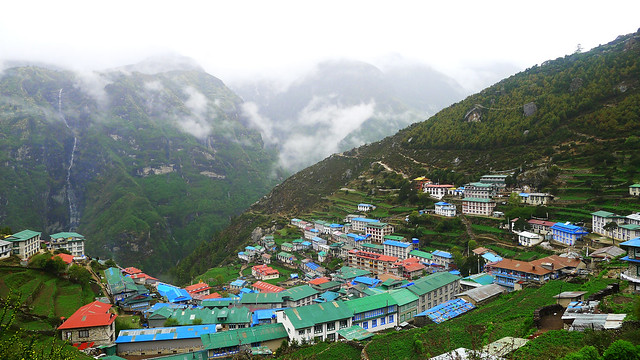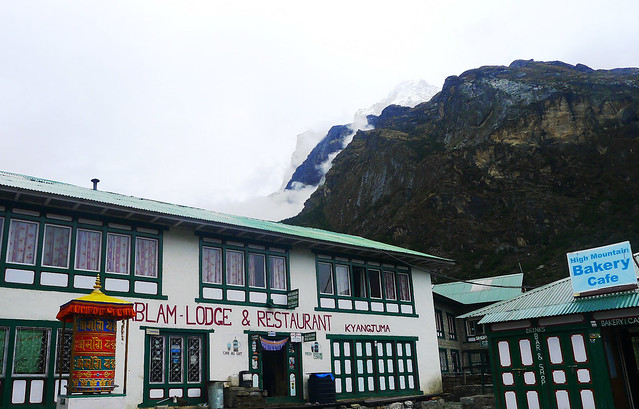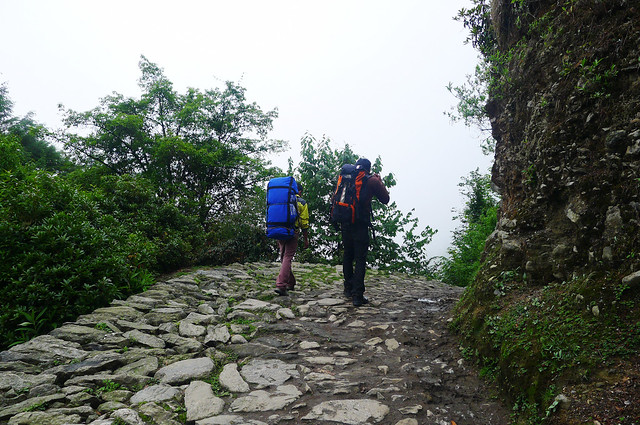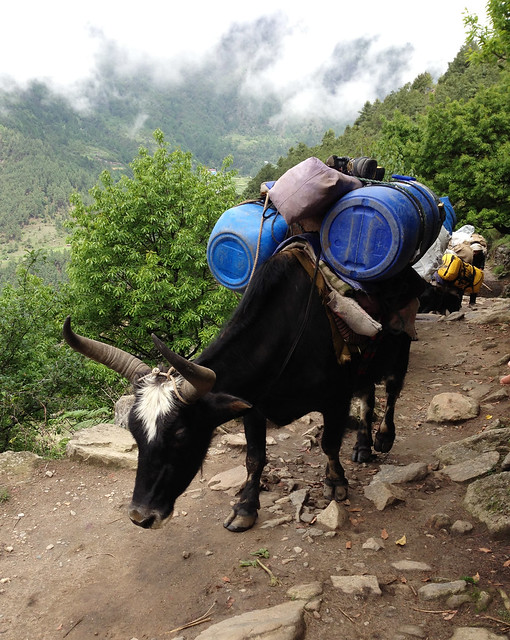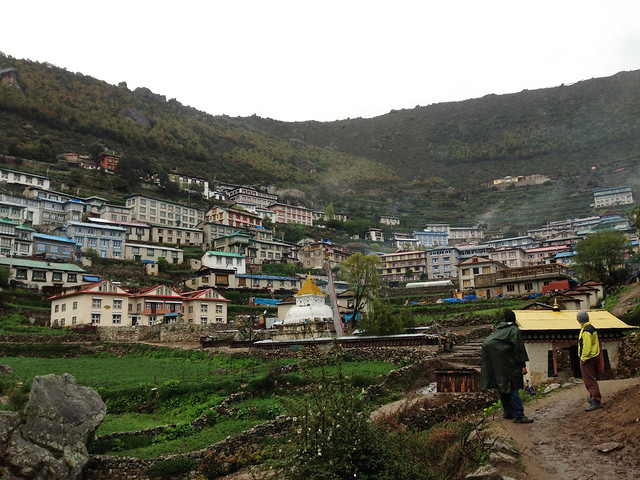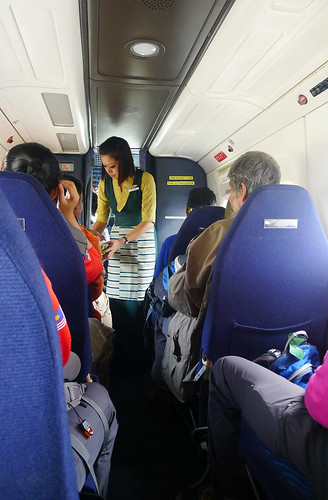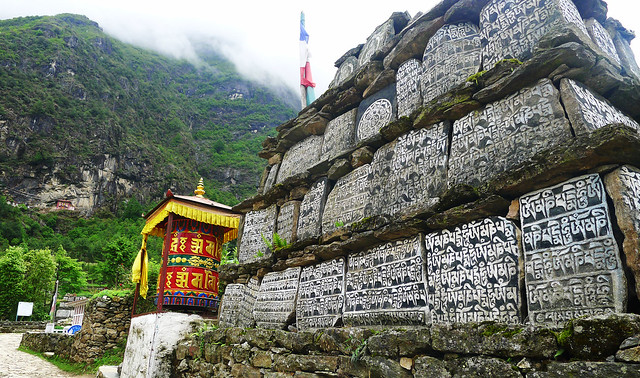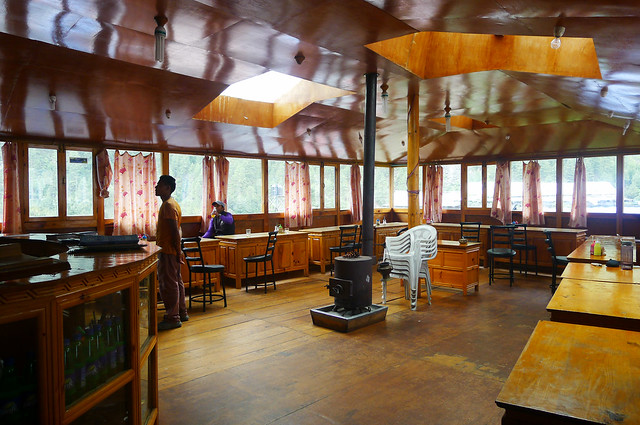To read all posts on my Everest Base Camp trek, click here for the complete series.
Day 7: June 4, 2013
I decided to start the day right with a bucket shower.
I don't know about other trekkers, but I would not have been able to survive the whole 12 days without a single bath. I am simply not programmed to give up any precious opportunity to have a shower. During this trek, I've been lucky so far to be staying in teahouses where the common toilets are situated inside, and not in outhouses that would require you to run out into the brutally cold night with headlamps on to answer the call of nature. (This also has a lot to do with how good your trek agency is in reserving teahouse rooms for you, and I feel lucky that Himalayan Planet Adventures always made sure I had a good bed and decent toilet waiting for me at the end of each trekking day.) And I was also able to shower 8 out of the 12 days on the trail, which ain't pretty bad!
A bucket shower, I was to learn, is different from a gas shower--the latter being quite a luxury and practically non-existent this high up on the trail. The bucket shower, while very basic, has its charms.
My bucket shower at the Dingboche teahouse consists of this contraption: a huge water drum on top of the teahouse roof with a hose connecting it to a shower head inside the common bathroom. Someone from the teahouse heats up water from the yak stove, carries the hot water buckets up to the roof, and fills up the water drum. All I need to do is switch on a valve inside the shower room and there you have it--hot water flowing from the water drum and right out of the shower head. It's really and truly a bucket shower! Quite ingenious and worth the price of 500 Nepalese rupees (USD 5-6). The rest of the world--especially in areas with no running water--stand to learn a lot from the Nepalis. I simply had to tell my UNICEF colleagues in the Water, Sanitation and Hygiene Section back in Manila about the bucket shower.
I breakfasted on milk porridge (otherwise known as oatmeal!) and hot chocolate that day. For the next few days until I returned to Kathmandu, I could not stomach anything else in the morning except oatmeal and hot chocolate. And I could never, ever finish my breakfast. Madan, ever the watchful guide, had this sort of disapproving look on his face every time I pushed away my bowl of barely eaten milk porridge; he would remind me that I needed energy to keep me going through the trek. What could I do, my appetite has failed me, I'd always say. I could only manage, at best, a few spoonfuls of oatmeal and a small cup of hot chocolate.
I had also gone without coffee for days, which was difficult and mind-blowing for a coffee addict like me. I had to actually stop drinking coffee around Day 3 because it was contributing to the palpitations I was already feeling high up on the trail. High altitude + coffee is a disaster waiting to happen.
We left Dingboche at 9:00 am, and even with the cold and mist, it was still a pleasant walking experience. The road to Thukla, our lunch stop, involved a green hilly landscape that eased my trek-weary state a little. But even with the easy rolling path, I had to stop walking every 10 minutes or so to catch my breath. The air was getting too thin for comfort.
Five minutes away from Thukla, we had to cross this horribly makeshift bridge of uneven rocks right above the river. Some parts were rocks, a short stretch involved thin rickety planks, and then there was some wire wrapped around the rocks to keep these steady and from eroding. Trip on those wires and you might end up falling into the river.
I wasn't able to take a photo of this bridge because I was, uh, busy keeping my balance and trying not to scream in terror. I've borrowed a photo of this Thukla bridge from another blog just to give you folks an idea of what the bridge looked like. (It really looks scarier in real life, to be honest.). Special thanks to Kwok Yeen Cheah of Outdoors Malaysia, who also writes about his Everest Base Camp experience.
I thought the bridge was going to be the highlight of Day 7, but the Himalayas had more in store for me apparently. After lunch, I went through what I felt was one of the toughest uphills I've ever encountered. It was the same brand of misery I felt on Day 2, and the climb to the top of the hill is something I can't forget.
I was stopping every two minutes during that climb to gasp and breathe in lungfuls of air. It didn't help that my nose was terribly clogged and it hurt to blow my nose all the time. The difficulty of that afternoon's walk had nothing to do with the terrain, which looked like your typical rocky hill with some steep inclines. But the altitude level had gotten so bad that no matter how I tried to fill up my lungs, I realized to my dismay that not much air was flowing in. And I had actually thought that the air back in Dingboche was already thin to begin with.
The cold and the thin air left me numb. I was on auto pilot, dragging my feet up the hill and regulating my breathing as best as I could. It reached the point where I was solely, desperately focusing on breathing in, breathing out while my arms and legs went through the automated motions of working the trekking poles and climbing up the path. Nothing else mattered to me except the sound of my attempts to breathe evenly. I thought about all those hours I spent in the 40-degree heated bikram yoga studio back in Manila, doing all those breathing sessions--and I fervently thanked all my yoga instructors then and there for teaching me how to breathe properly.
Dhan Kumar had gone way ahead and I was to see him later after a few hours. I asked Madan to stay in front of me, as always, because I relied on him to show me the path amidst the fog that was enveloping us on all sides on that hill. Because there was no energy left for talking during that excruciating climb that took more than an hour, I just concentrated on breathing. When I stopped along the path to take a break and blow my nose, I would allow myself the most banal of thoughts, like if something bad happened to me, I'd probably never find out how Holmes cheated death in his fall in Sherlock's Season 2. I also wondered, fleetingly, how the rest of the world was reacting, now that HBO's Game of Thrones had just aired the Red Wedding episode a few days ago--and if it was as graphic as the scene in the novel.
When I finally made it to the top, Madan was waiting for me by this long rock ledge that was momentarily blocking out most of the wind. I gladly sat down beside him to take in more breaths of air (which was barely there) and take stock of my surroundings. What I saw sent a little chill to my heart.
There, on top of that hill, in the swirling mist, was a graveyard of sorts. The place is called Dugla Pass, and it was where many of the memorials are placed in honor of those who summitted Everest and died shortly thereafter. It was depressing to wander about and read the epitaphs--sobering reminders of how deadly and treacherous Mount Everest can be.
It was only 3:00 pm, yet the fog and dark sky that day made us feel that we needed to hurry along and reach Lobuche as soon as possible. Mercifully enough, the next one and a half hours was spent on a rocky, yet relatively flat expanse of land. Dhan Kumar, always with a boyish smile on his face regardless of the weather and surroundings, came back for us and took my day pack even though I was not having a hard time with it. In fact, anything after that climb up to Dugla Pass felt like a breeze.
As we neared the little town of Lobuche, I was treated to wonderful views of Mounts Nuptse, Kangtega and Thamserku--beautiful and majestic mountains in their own right yet sadly dwarfed by the ever popular Everest. I said a little prayer of thanks for getting through yet another challenging day. And no matter how hard a day's trek would be, the sight of the Himalayan mountains always thrilled me to the core.
We arrived in Lobuche (elevation: 4,928 meters / 16,164 feet) at 4:30 pm, with enough time to rest, eat dinner, and prepare for the big day tomorrow--Everest Base Camp on my 33rd birthday.
* * *
If you want the same Everest Base Camp trek experience I had, visit Himalayan Planet Adventures and go for the 16-day Everest Base Camp trek package.
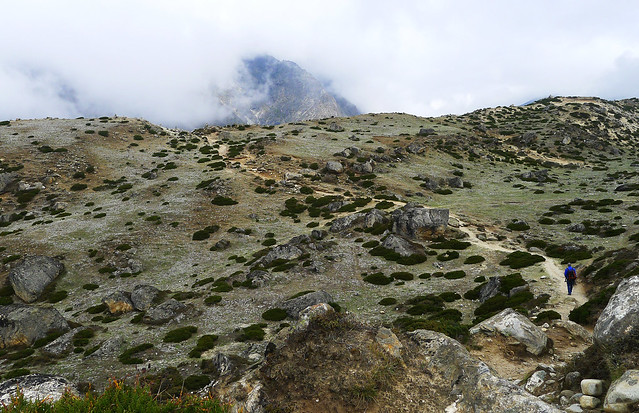 |
| The beautiful paths situated between Dingboche and Lobuche. My guide Madan is the blue figure on the right. |
Day 7: June 4, 2013
I decided to start the day right with a bucket shower.
I don't know about other trekkers, but I would not have been able to survive the whole 12 days without a single bath. I am simply not programmed to give up any precious opportunity to have a shower. During this trek, I've been lucky so far to be staying in teahouses where the common toilets are situated inside, and not in outhouses that would require you to run out into the brutally cold night with headlamps on to answer the call of nature. (This also has a lot to do with how good your trek agency is in reserving teahouse rooms for you, and I feel lucky that Himalayan Planet Adventures always made sure I had a good bed and decent toilet waiting for me at the end of each trekking day.) And I was also able to shower 8 out of the 12 days on the trail, which ain't pretty bad!
A bucket shower, I was to learn, is different from a gas shower--the latter being quite a luxury and practically non-existent this high up on the trail. The bucket shower, while very basic, has its charms.
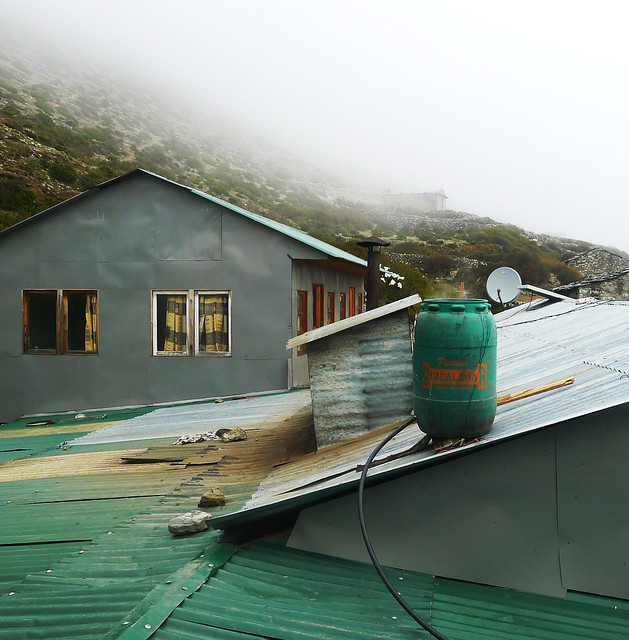 |
| The amazing bucket shower -- Nepali-style |
I breakfasted on milk porridge (otherwise known as oatmeal!) and hot chocolate that day. For the next few days until I returned to Kathmandu, I could not stomach anything else in the morning except oatmeal and hot chocolate. And I could never, ever finish my breakfast. Madan, ever the watchful guide, had this sort of disapproving look on his face every time I pushed away my bowl of barely eaten milk porridge; he would remind me that I needed energy to keep me going through the trek. What could I do, my appetite has failed me, I'd always say. I could only manage, at best, a few spoonfuls of oatmeal and a small cup of hot chocolate.
I had also gone without coffee for days, which was difficult and mind-blowing for a coffee addict like me. I had to actually stop drinking coffee around Day 3 because it was contributing to the palpitations I was already feeling high up on the trail. High altitude + coffee is a disaster waiting to happen.
We left Dingboche at 9:00 am, and even with the cold and mist, it was still a pleasant walking experience. The road to Thukla, our lunch stop, involved a green hilly landscape that eased my trek-weary state a little. But even with the easy rolling path, I had to stop walking every 10 minutes or so to catch my breath. The air was getting too thin for comfort.
Five minutes away from Thukla, we had to cross this horribly makeshift bridge of uneven rocks right above the river. Some parts were rocks, a short stretch involved thin rickety planks, and then there was some wire wrapped around the rocks to keep these steady and from eroding. Trip on those wires and you might end up falling into the river.
I wasn't able to take a photo of this bridge because I was, uh, busy keeping my balance and trying not to scream in terror. I've borrowed a photo of this Thukla bridge from another blog just to give you folks an idea of what the bridge looked like. (It really looks scarier in real life, to be honest.). Special thanks to Kwok Yeen Cheah of Outdoors Malaysia, who also writes about his Everest Base Camp experience.
 |
| Bridge at Thukla. Photo Credit: Kwok Yeen Cheah, Outdoors Malaysia (2012) |
I thought the bridge was going to be the highlight of Day 7, but the Himalayas had more in store for me apparently. After lunch, I went through what I felt was one of the toughest uphills I've ever encountered. It was the same brand of misery I felt on Day 2, and the climb to the top of the hill is something I can't forget.
I was stopping every two minutes during that climb to gasp and breathe in lungfuls of air. It didn't help that my nose was terribly clogged and it hurt to blow my nose all the time. The difficulty of that afternoon's walk had nothing to do with the terrain, which looked like your typical rocky hill with some steep inclines. But the altitude level had gotten so bad that no matter how I tried to fill up my lungs, I realized to my dismay that not much air was flowing in. And I had actually thought that the air back in Dingboche was already thin to begin with.
The cold and the thin air left me numb. I was on auto pilot, dragging my feet up the hill and regulating my breathing as best as I could. It reached the point where I was solely, desperately focusing on breathing in, breathing out while my arms and legs went through the automated motions of working the trekking poles and climbing up the path. Nothing else mattered to me except the sound of my attempts to breathe evenly. I thought about all those hours I spent in the 40-degree heated bikram yoga studio back in Manila, doing all those breathing sessions--and I fervently thanked all my yoga instructors then and there for teaching me how to breathe properly.
Dhan Kumar had gone way ahead and I was to see him later after a few hours. I asked Madan to stay in front of me, as always, because I relied on him to show me the path amidst the fog that was enveloping us on all sides on that hill. Because there was no energy left for talking during that excruciating climb that took more than an hour, I just concentrated on breathing. When I stopped along the path to take a break and blow my nose, I would allow myself the most banal of thoughts, like if something bad happened to me, I'd probably never find out how Holmes cheated death in his fall in Sherlock's Season 2. I also wondered, fleetingly, how the rest of the world was reacting, now that HBO's Game of Thrones had just aired the Red Wedding episode a few days ago--and if it was as graphic as the scene in the novel.
When I finally made it to the top, Madan was waiting for me by this long rock ledge that was momentarily blocking out most of the wind. I gladly sat down beside him to take in more breaths of air (which was barely there) and take stock of my surroundings. What I saw sent a little chill to my heart.
 |
| At Dugla Pass, a place full of memorials for those who died on Everest |
 |
| One of the many memorials at Dugla Pass |
As we neared the little town of Lobuche, I was treated to wonderful views of Mounts Nuptse, Kangtega and Thamserku--beautiful and majestic mountains in their own right yet sadly dwarfed by the ever popular Everest. I said a little prayer of thanks for getting through yet another challenging day. And no matter how hard a day's trek would be, the sight of the Himalayan mountains always thrilled me to the core.
We arrived in Lobuche (elevation: 4,928 meters / 16,164 feet) at 4:30 pm, with enough time to rest, eat dinner, and prepare for the big day tomorrow--Everest Base Camp on my 33rd birthday.
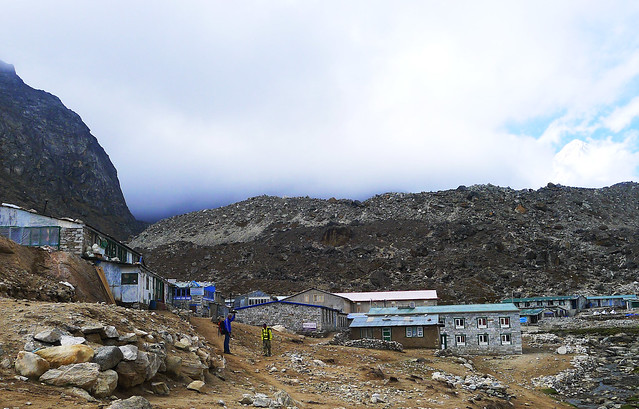 |
| Yes, this small settlement is the entire area of Lobuche already. Elevation: 4,928 m / 16,164 ft. |
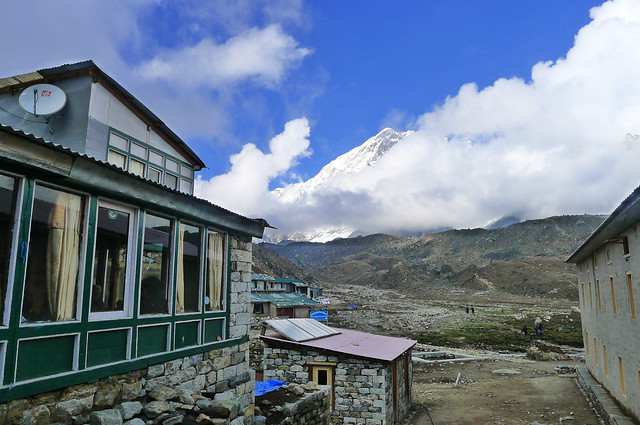 |
| My view from my room at the Lobuche teahouse |
If you want the same Everest Base Camp trek experience I had, visit Himalayan Planet Adventures and go for the 16-day Everest Base Camp trek package.
